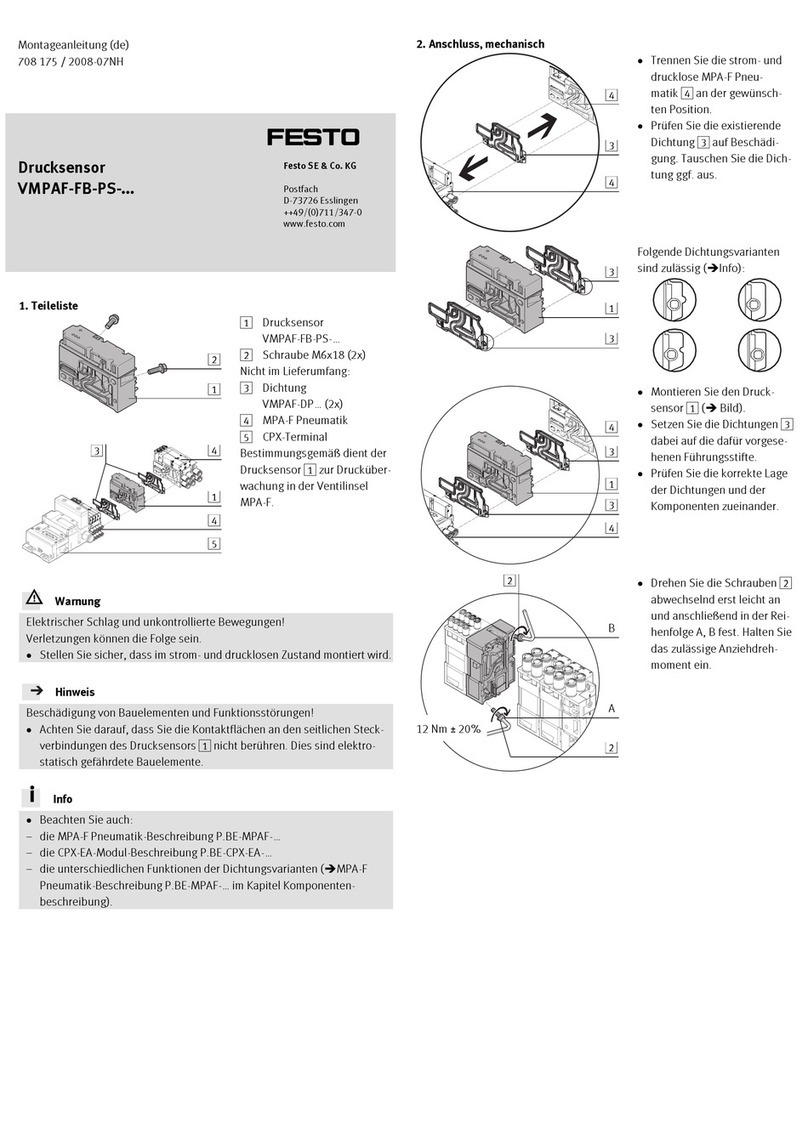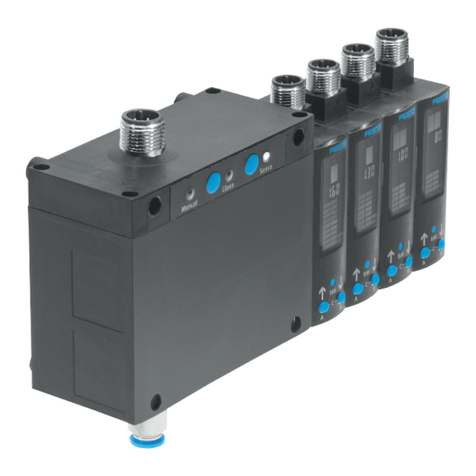Festo SFAB User manual

SFAB
Flow sensor
Festo SE & Co. KG
Ruiter Straße 82
73734 Esslingen
Deutschland
+49 711 347-0
www.festo.com
Operating instructions
8156241
2021-05d
[8156243]
Translation of the original instructions
© 2021 all rights reserved to Festo SE & Co. KG
1About this document
1.1 Applicable Documents
All available documents for the product è www.festo.com/sp.
2 Safety
2.1 General safety instructions
–Only use the product in original status without unauthorised modifications.
–Only use the product if it is in perfect technical condition.
–Observe labelling on the product.
–Condensation, oil mist, foreign matter and other contaminants in the com-
pressed air can damage the product. Only use media in accordance with the
specifications è Technical data.
–This product can generate high frequency malfunctions, which may make it nec-
essary to implement interference suppression measures in residential areas.
2.2 Intended use
The SFAB is designed to monitor changes in the flow rate and air consumption of
gaseous media in piping systems or terminals in industry.
2.3 Training of qualified personnel
Work on the product may only be carried out by qualified personnel who can
evaluate the work and detect dangers. The qualified personnel have skills and
experience in dealing with electropneumatic (open-loop) control technology.
2.4 Range of application and approvals
Certain configurations of the product have been certified by Underwriters Labora-
tories Inc. (UL) for the USA and Canada. These configurations bear the following
mark:
Fig.1
UL Recognized Component Mark for Canada and the United States. Only for
connection to an NEC Class 2 supply. Raccorder Uniquement a un circuit de Classe
2.
Observe the following if the UL requirements are to be complied with in your
application:
• Regulations for complying with the UL certification can be found in the sepa-
rate UL-specific special documentation. The technical data listed there take
priority.
• The technical data in this documentation may show values deviating from this.
3Additional information
–Contact the regional Festo contact if you have technical problems
è www.festo.com.
–Accessories and spare parts è www.festo.com/catalogue.
4Product overview
4.1 Product design
1
2
3
4
5
6
7
8
9
Fig. 2: SFAB
1Supply port 1
2Display
3B pushbutton
4Edit button
5A pushbutton
6Plug for the electrical connection
(M12)
7Hole for plate mounting
8Supply port 2
9Mounting slide for H-rail and wall
mounting (rear)
4.2 Functional principle
The SFAB uses a thermal measurement method. Here, the amount of heat drawn
from a heated surface of the sensor by the medium flowing past it is calculated.
Through the amount of heat removed, the flow rate or accumulated air consump-
tion is determined and shown on the display. The connection to higher-level
systems is implemented through 2 binary outputs (Out A/OutB) and one analogue
output. Switching points can be defined for both binary outputs. Switching points
for both binary outputs are possible for flow rate measurement, a consumption
switching pulse for output A (OutA) is possible for cumulative air consumption
measurement. The combination of cumulative air consumption measurement
(OutA) and flow rate measurement (OutB) is possible. The flow value is output
via the analogue output.
5 Assembly
5.1 H-rail (manifold assembly)
1. Maintain lateral distance x = 10 mm to earthed surfaces.
2. Hang SFAB in H-rail.
3. Press SFAB in the direction of the arrow.
ÄSFAB snaps into place.
5.2 Wall mounting
1. Maintain lateral distance x = mm to earthed surfaces.

2. Fasten the adapter plate with 2 screws M3.
3. Hang the SFAB in the adapter plate.
4. Press SFAB in the direction of the arrow.
ÄSFAB snaps into place.
5.3 Plate mounting
1. Maintain lateral distance x = mm to earthed surfaces.
2. Fasten SFAB with washers and 2 screws M4.
–Tightening torque: 1 Nm
5.4 Rotate display
The display can be rotated in 90° steps. The turning range is limited to approx.
270° by a stop.
Fig. 3: Rotate display
6 Installation
6.1 Pneumatic installation
• Mount the hoses to port 1 and port 2 (flow direction è marked on the
product).
If the tubing is incorrect, the measured values are shown flashing on the display.
6.2 Electrical installation
WARNING
Risk of injury due to electric shock.
• For the electrical power supply, use only PELV circuits in accordance with IEC
60204-1/EN 60204-1 (Protective Extra-Low Voltage, PELV).
•Observe the general requirements of IEC 60204-1/EN 60204-1 for PELV circuits.
• Only use voltage sources that ensure a reliable electric separation from the
mains network in accordance with IEC 60204-1/EN 60204-1.
1. Use signal lines that are shorter than 10 m.
2. Configure binary outputs according to the wiring.
–Tightening torque for the union nut at the plug: max. 0.5 Nm
Pin Wire colour1) Allocation Plug
1 Brown (BN) Operating voltage
+24 V DC
M12, 5-pin
2 White (WH) Binary output B (OutB)
3 Blue (BU) 0 V
4 Black (BK) Binary output A (OutA)
5 Grey (GY) Analogue output C
1) When using the connecting cable from the accessories.
Tab. 1: Pin allocation
Circuit diagrams
SFAB-...-2SA SFAB-...-2SV
I
qBN +24 V
1
WH
BK
BU 0 V
GY RL
PNP/NPN
4
2
5
3
qBN +24 V
1
WH
BK
BU 0 V
GY RL
PNP/NPN
U
4
2
5
3
Tab. 2: Circuit diagrams
7Commissioning
1. Switch on operating voltage.
ÄSFAB is in RUN mode.
2. Define the switching behaviour of the binary outputs.
–For flow measurement [FLW]: switching points [SP] and hysteresis [Hy]
–For cumulative air consumption measurement [ConS] with OutA only: con-
sumption switching impulse [CI]
7.1 Switching outputs
7.1.1 Switching functions
7.1.1.1 Threshold value comparator in the flow rate measurement for OutA or
OutB
Function NO (normally open) NC (normally closed)
Switching function:
–1 switching point (SP)
TEACH mode:
–2 teach points (TP1, TP2)
Tab. 3: Threshold value comparator
7.1.1.2 Window comparator in the flow rate measurement for OutA or OutB
Function NO (normally open) NC (normally closed)
Switching function:
–2 switching points (SP.Lo,
SP.Hi)
TEACH mode:1)
–2 teach points (TP1, TP2)
–TP1 = SP.Lo, TP2 = SP.Hi
1) SP.Lo = smaller value, SP.Hi = larger value, independent of the teach sequence
Tab. 4: Window comparator
7.1.1.3 Consumption switching pulses [CI] for cumulative air consumption
measurement for OutB
A threshold value for air consumption can be set with the consumption switching
impulse [CI]. If the set threshold value is reached, a switching impulse is emitted
at the output Out A for 100 ms. With each switching impulse, measurement of the
air consumption is started again.
Setting NO (N/O (normally open) con-
tact)
Setting NC (N/C (normally closed)
contact)
Tab. 5: Consumption switching pulses

7.2 Display components
Symbol Description
OutA/OutB Switching output A/switching output B
Lock Security code active (blocked against unauthorised programming)
Run Accumulated air consumption measurement is active in RECORDER
mode
Option Sensor is set to a standard condition that differs from the factory
setting
Stop Air consumption measurement stopped
Switching output set/not set
Threshold value comparator
Window comparator
Air consumption switching mode (consumption – only for OutA)
Pulse for accumulated air consumption (consumption impulse)
Switching point
Lower switching point (switching point - low)
Upper switching point (switching point - high)
Hysteresis
N/O contact (normally open)
N/C contact (normally closed)
Switching mode flow rate (flow - only for OutA)
Minimum flow rate (flow low)
Maximum flow rate (flow high)
Special menu
Analogue filter
Digital filter
Display red with switching status ON and/or logic 1
Display red with switching status OFF and/or logic 0
Positive switch output
Zero switch output
Segments are lighted: graphic display of the current measured value
related to the maximum measured value of the measuring range
Running light (1 segment): air consumption measurement for OutA or
RECORDER mode active
3 segments flash: hysteresis value is displayed
1 segment flashes:
–Segment 6: switching point SP or SP.Lo is displayed
–Segment 8: switching point SP.Hi is displayed
–Segment 1: min. flow rate (F.Lo) is displayed
–Segment 10: max. flow rate (F.Hi) is displayed
Tab. 6: Symbols on the display
7.3 Preparing commissioning
The product in basic status is in RUN mode. The current measurement values are
displayed. The basic status can be reached from other modes by:
–Pressing Edit button for 3 seconds
–Expiration of monitoring time, timeout
1. Switch on operating voltage.
ÄThe SFAB is in RUN mode.
2. Check the SFAB settings è 7.6 SHOW mode.
7.4 Symbols for representing the menu structure
Symbol Description
Automatic return to the basic status (RUN mode) when the monitoring
time has expired (here 80 seconds)
In order to return manually to the basic status (RUN mode), press the
EDIT button for 3 seconds.
Generate flow rate (for teaching the measured value - here Flow 1)
The symbol on the display flashes (here OutB)
Security code active (lock - blocked against unauthorised program-
ming)
Security code inactive (lock)
Press key (here A key).
Press A key or B key. SFAB switches to the setting indicated by the
arrows.
Press A and B keys simultaneously.
Press key (here A key) and EDIT button simultaneously.
Press A key or B key to set the desired value.
Display for a value or switching point. Value can be set.
Symbol Description
Press the Edit button.
Branching in the menu
Tab. 7
7.5 RUN mode
The following values are displayed in RUN mode:
–Measurement values for the flow rate (in l/min, scfm or l/h)
–Measurement values for air consumption (in m³, scf or l)
–Signal states of the switching outputs OutA, OutB (set, not set)
If the measured value display flashes, one of the following errors has occurred:
• Measured value outside the permissible measuring range
• Incorrect tubing è 6.1 Pneumatic installation
7.6 SHOW mode
In SHOW mode, the current settings for the switching outputs Out A and Out B are
displayed.
The SFAB must be in RUN mode.
•To start the SHOW mode for the respective switching output, press the A key
(OutA) or B key (OutB).
If there are errors, the corresponding error numbers are displayed first after
pressing the A / B pushbutton.
•To display the settings one by one, press the A/B pushbutton repeatedly.
When all settings have been displayed, the SFAB goes back into RUN mode when
the A pushbutton / B pushbutton are pressed again and displays the current
measurement value for the corresponding output.
Thus, the SHOW mode can also be used to switch the display, e. g. to switch
between the displayed measured values for a combination of air consumption
measurement and flow rate measurement.
The following settings will be displayed for outA:
–With flow measurement [FLW]:
–Switching function [threshold value or window comparator]
–Switching point [SP], Switching points [SP.Lo] and [SP.Hi]
–Hysteresis [Hy]
–Switching element function [no/nc] (N/O contact/N/C contact)
–Minimum flow rate [F.Lo] (flow low)
–Maximum flow rate [F.Hi] (flow high)
To delete the minimum or maximum value, press the EDIT button.
–For air consumption measurement [ConS]:
–Air consumption switching impulse [CI]
–Switching element function [no/nc] (N/O contact/N/C contact)
–Minimum value flow rate [F.Lo]
–Maximum value flow rate [F.Hi]
To delete the minimum or maximum value, press the EDIT button.
The following settings will be displayed for OutB:
–Switching function [threshold value or window comparator]
–Switching point [SP], Switching points [SP.Lo] and [SP.Hi]
–Hysteresis [Hy]
–Switching element function [no/nc] (N/O contact/N/C contact)
–Status colour change [bLUE/rON/rOFF]
–Minimum value flow rate [F.Lo]
–Maximum value flow rate [F.Hi]
To delete the minimum or maximum value, press the EDIT button.

Fig. 4: Menu structure for SHOW mode
7.7 EDIT mode
The following settings can be made in EDIT mode:
–Switching mode for OutA (air consumption [ConS] or flow rate [FLW] )
–Switching function (threshold value or window comparator for OutA and OutB)
–Switching points [SP] for OutA and OutB
–Air consumption switching impulse [CI] only for OutA in switching mode [ConS]
–Hysteresis [Hy] for OutA and OutB
–Switching element function [no/nc] for OutA and OutB
–Colour change of the display from blue to red for flow mode (for OutB)
In addition, the following settings can be made in the special menu:
–Switching of the standard conditions via [Option] (OFF, 1, 2)
–Physical units for flow rate [FLW] (l/h, scfm, l/min)
–Analogue filter [AnA.F]
–Digital filter [dIG.F]
–Physical units for air consumption [ConS] (m3, scf, l)
–Switching output [nPn/PnP]
–Security code [Lock]
Fig. 5: EDIT mode menu structure
7.7.1 Starting EDIT Mode
WARNING
Manipulation of signal statuses may cause serious personal injury, depending
on the functioning of the machine/system.
• Note that if the switching status of the outputs is modified in EDIT mode, the
new status will be effective immediately.
The following settings can be selected with the control buttons (A/B pushbutton):
–Switching output for which the characteristics is to be set
–Special menu
1. Press the Edit button.
ÄEDIT mode is active and [OutA] flashes. Lock flashes with active security
blocking.
2. Press the A/B pushbuttons until the chosen security code is set.
3. Press the Edit button.
ÄEDIT mode is active and [OutA] flashes.
7.7.2 Setting the switching characteristics of the switching outputs
Both switching outputs (OutA/OutB) can be set for flow measurement. Switching
output OutA can alternatively be set for the cumulated air consumption meas-
urement. The cumulative air consumption measurement (OutA) and flow rate
measurement (OutB) can be combined.
7.7.2.1 Setting the switching function for flow measurement
The process for setting the switching outputs is fundamentally the same. Addi-
tionally, the switching mode [FLW] must be selected for Out A since Out A can
also be configured for air consumption measurement. The colour change for the
display can also be set for OutB. In the following, the process is described using
the switching output OutA.
Requirement
–SFAB is in EDIT mode and [OutA] flashes
1. Press the Edit button to confirm the selection.
Ä[FLW] or [ConS] flashes.
2. Select flow rate measurement (FLW) with the A-/B pushbuttons.
3. Press the Edit button to confirm the selection.
ÄThe currently set switching function flashes.
4. Select the desired switching function with the A/B pushbuttons.
5. Press the Edit button to confirm the selection.
Ä[SP] or [SP.Lo] flashes.
6. Set the switching point (SP or SP.Lo) with the A/B buttons.
7. Press the Edit button to confirm the set value.
ÄWith switching function window comparator: [SP.Hi] flashes. For
switching function threshold value comparator: continue with step 10.
8. Set the value (SP.Hi) with the A/B pushbuttons.
9. Press the Edit button to confirm the set value.
Ä[Hy] flashes.
10. Set the value for the hysteresis (Hy) with the A/B pushbuttons.
11. Press the Edit button to confirm the set value.
Ä[N/O] or [N/C] flashes.
12. Select the switching element function N/O/N/C with the A/B pushbuttons.
13. Press the Edit button to confirm the set value.
ÄSFAB is in RUN mode.
14. Check whether the SFAB switches as desired with a test run (vary the flow
rate).
7.7.2.2 Setting the switching function for air consumption measurement
Requirement
–SFAB is in EDIT mode and [OutA] flashes
1. Press the Edit button to confirm the selection.
Ä[FLW] or [ConS] flashes.
2. Select flow measurement [ConS] with the A/B buttons.
3. Press the Edit button to confirm the selection.
Ä[CI] flashes.
4. Set the value for the air consumption switching impulse [CI] with the A/B
buttons.
5. Press the Edit button to confirm the set value.
Ä[N/O] or [N/C] flashes.
6. Select the switching element function N/O/N/C with the A/B pushbuttons.
7. Press the Edit button to confirm the set value.
ÄSFAB is in RUN mode.
8. Check whether the SFAB switches as desired with a test run (flow rate).
7.7.3 Setting the colour change (only for OutB)
In order to detect the system status over longer distances, a colour change can be
set at the OutB output. If the set switching threshold is exceeded or not reached,
the colour of the display changes.
The following settings can be selected:
–r.ON
–Display is red when the switching output is High (1).
–Display is blue if the switching output is Low (0).
–r.OFF
–Display is red when the switching output is Low (0).
–Display is blue if the switching output is High (1).
–bLUE

–Display is blue; the colour change function is switched off.
r.ON r.OFF bLUE
blue red red blue blue
Tab. 8: Colour change
Requirement
–SFAB is in EDIT mode and [OutA] flashes
1. Press B button.
Ä[OutB] flashes.
2. Press the Edit button to confirm the selection.
3. Press the Edit button repeatedly until [rON], [rOFF] or [bLUE] flashes in the
display.
4. Select the desired setting (rON, rOFF or bLUE) using the A/B pushbuttons.
5. Press the Edit button to confirm the selection.
ÄSFAB is in RUN mode.
7.7.4 Setting the special menu
The following settings can be undertaken in the special menu:
–Standard conditions
–Physical units for flow rate (l/h, scfm or l/min)
–Analogue filter [AnA.F] with filter time constant in ms
–Digital filter [dIG.F] with smoothing in 7 levels for display and switching output
–Physical units for air consumption (m3, scf or l)
–Select the switching output [PnP] or [nPn]
–Remove security blocking [Lock] with security code
Requirement
–SFAB is in EDIT mode and [OutA] flashes
1. Press the A or B pushbutton repeatedly until the menu (SPEC) is selected.
Ä[SPEC] flashes.
2. Press the Edit button to confirm the selection.
Ä[Option] flashes. The standard conditions (OFF, 1 or 2) can be set.
7.7.4.1 Setting standard conditions
The air mass flow measured and output by the SFAB refers to standard conditions.
The SFAB is factory calibrated to the physical standard conditions according to
DIN 1343.
Changing the reference standard only adjusts the display on the sensor. The
analogue value at the analogue output still refers to DIN 1343 and must be
converted.
• Multiply the end value of the flow measurement range by the specified correc-
tion factor.
• End value of the analogue output refers to the end value of the measuring
range. This changes the transfer function.
REF/Cond Off 1 2
Standard DIN 1343 ISO 2533 ISO 6358
Air pressure (absolute) [kPa] 101.325 101.325 100
Temperature [°C] 0 15 20
Humidity [%] 0 0 65
Correction factor, measurement range limit value 1 1.055 1.087
Tab. 9: Standard conditions for flow rate and volume units
1. Select the desired setting (OFF, 1 or 2) using the A-/B pushbuttons.
2. Press the Edit button to confirm the selection.
Ä[FLW] is displayed and the set value flashes. The unit for the flow rate
(l/h, scfm or l/min) can be set.
7.7.4.2 Setting the physical unit for the flow rate
For the types SFAB-600U and SFAB-1000U, the unit l/h cannot be set due to
display reasons.
1. Select the desired setting (l/h, scfm or l/min) using the A-/B pushbuttons.
2. Press the Edit button to confirm the selection.
Ä[AnA.F] and the set value are displayed. The analogue filter can be set.
The selected physical unit is shown in RUN mode in the display at the bottom
right.
7.7.4.3 Setting filter time constant for the analogue filter
The rise time (filter time constant) of the analogue output can be changed (default
value = 60 ms) with the analogue filter.
1. Select the value for the filter time constant (15 ms, 30 ms, 60 ms, 125 ms, 250
ms, 500 ms or 999 ms) with the A/B pushbuttons.
2. Press the Edit button to confirm the set value.
Ä[dIG.F] and the set value flash. The digital filter can be set.
7.7.4.4 Setting smoothing for the digital filter
The display values can be smoothed with the digital filter. The degree of
smoothing can be set in 6 steps from d1 = low smoothing to d6=maximum
smoothing. The switch-on/switch-off time of the switching outputs rises as the
smoothness is increased. With d.Off the smoothing is deactivated.
Fig. 6: Signal flow from the analogue filter to the digital filter
A high filter time constant and high smoothing can result in a switching time of
several seconds.
1. Select the value for cushioning (d1 to d6 or d.OFF) with the A/B pushbuttons.
2. Press the Edit button to confirm the set value.
Ä[ConS] is displayed and the currently selected value flashes. The unit for
the air consumption (m3, scf or l) can be set.
7.7.4.5 Setting the physical unit for the air consumption
1. Select the desired setting (m3, scf or l) with the A/B pushbuttons.
2. Press the Edit button to confirm the set value.
ÄThe currently set value [PnP] or [nPn] for the switching element output
flashes. The switching element output can be set.
7.7.4.6 Setting switching element output
The two switching outputs can be set as positive switches (PNP) or as zero
switches (NPN) with the integrated push-pull step.
1. Select the desired setting (PNP or NPN) with the A/B pushbuttons.
2. Press the Edit button to confirm the selection.
Ä[Lock] flashes. The security code can be set.
7.7.4.7 Setting the security code
A numerical code of up to 4 digits can be set to protect the setting from unau-
thorised access. The security code must be entered every time the settings are
changed (EDIT mode and TEACH mode).
1. Set the desired security code with the A/B buttons.
2. Press the Edit button to confirm the selection.
ÄThe SFAB is in RUN mode.
Other Festo Accessories manuals

Festo
Festo SRAP-M-CA1 Series User manual

Festo
Festo CP Lab User manual
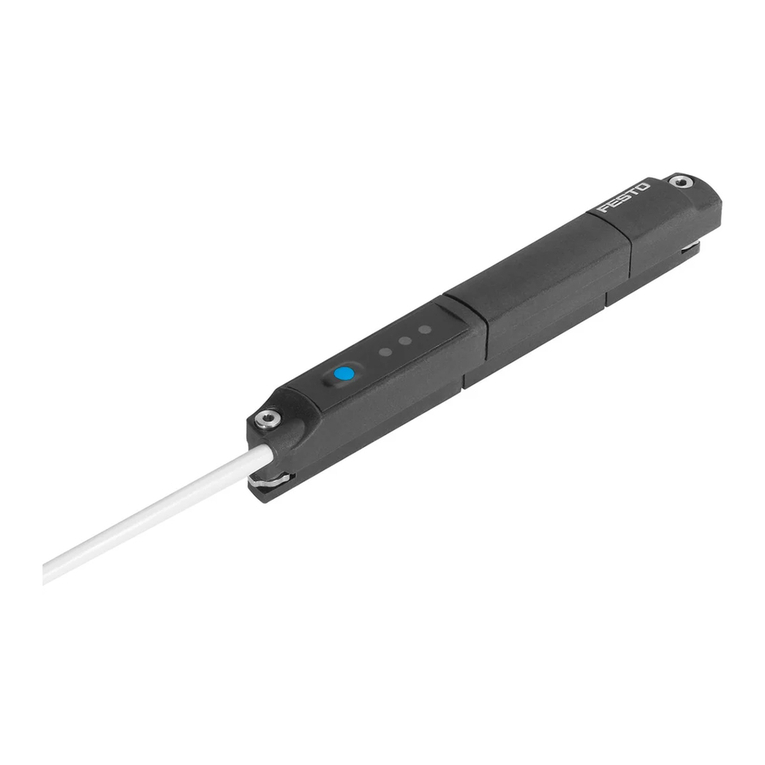
Festo
Festo SDAT-MHS User manual

Festo
Festo SFAB-PNLK Series User manual

Festo
Festo SRBG User manual
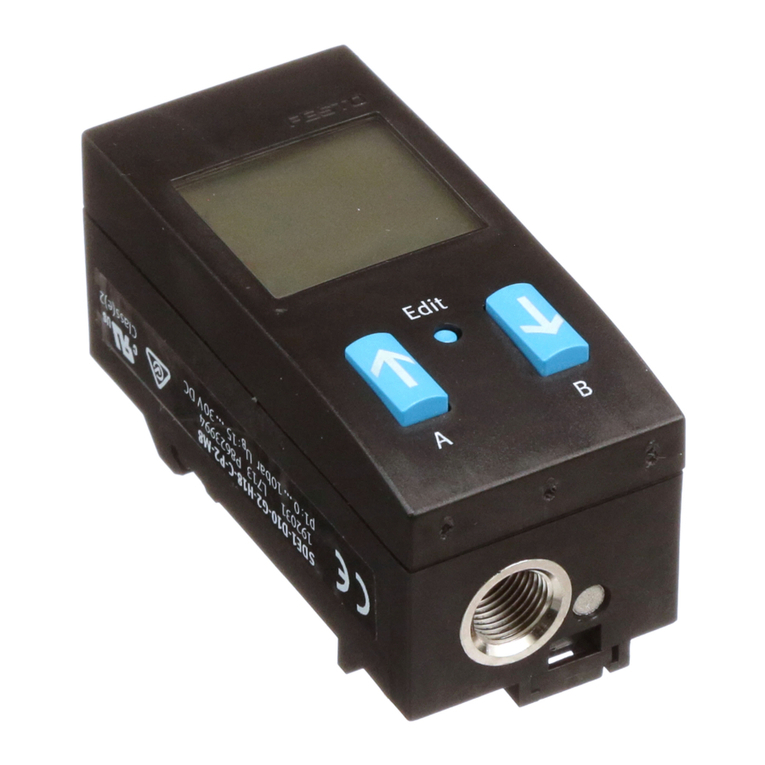
Festo
Festo SDE1 Series User manual
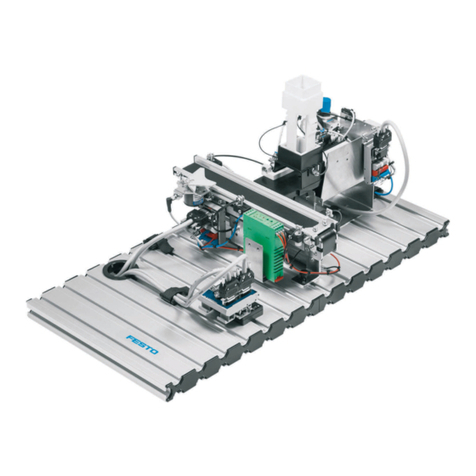
Festo
Festo MPS 8034566 User manual
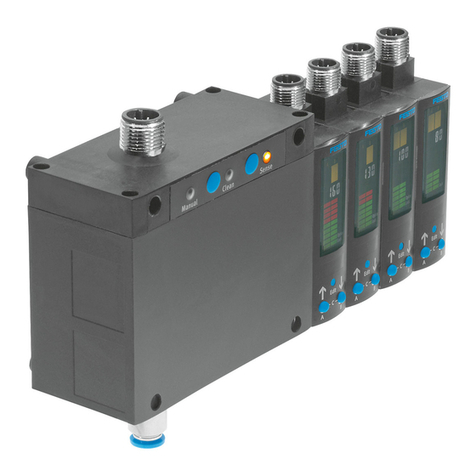
Festo
Festo SOPA-C series User manual

Festo
Festo SFAB Parts list manual
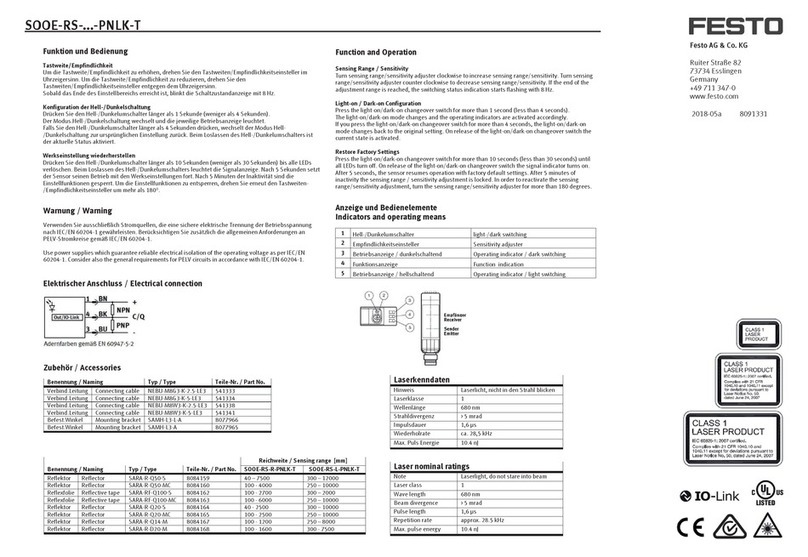
Festo
Festo SOOE-RS PNLK-T Series User manual

Festo
Festo SFAW Series User manual
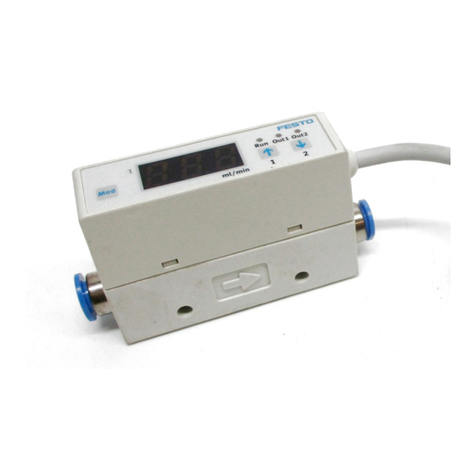
Festo
Festo SFE3 Series User manual

Festo
Festo SFAH Parts list manual
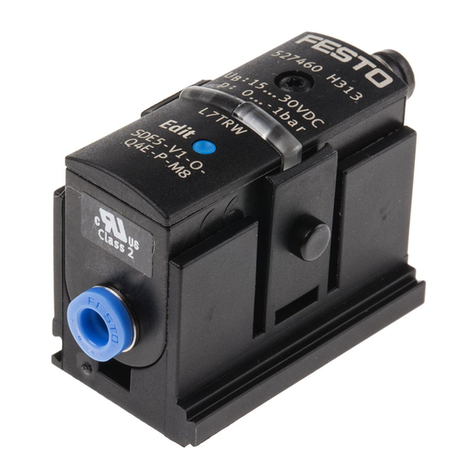
Festo
Festo SDE5 series Parts list manual

Festo
Festo SDE5 series User manual
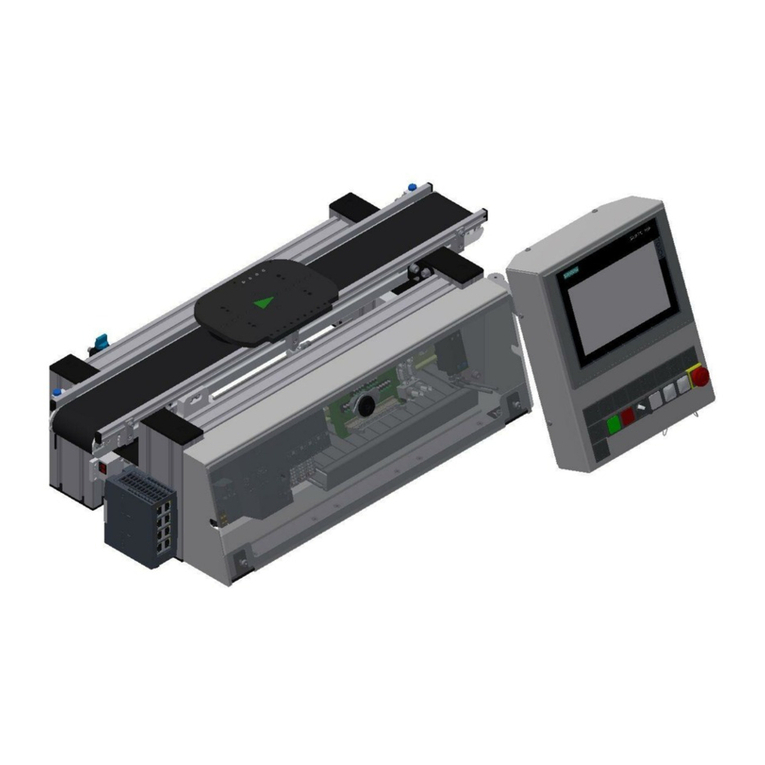
Festo
Festo CP Lab User manual
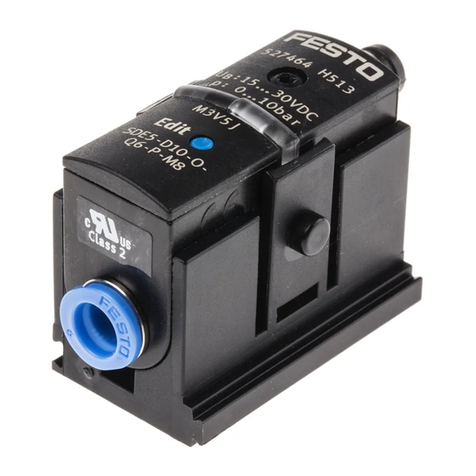
Festo
Festo SDE5 series User manual
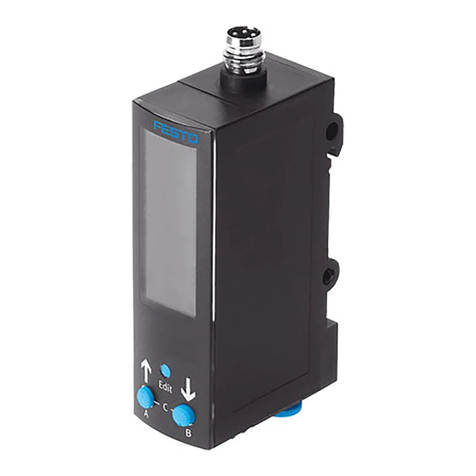
Festo
Festo SDE3 series User manual

Festo
Festo SBSI-EN Service manual
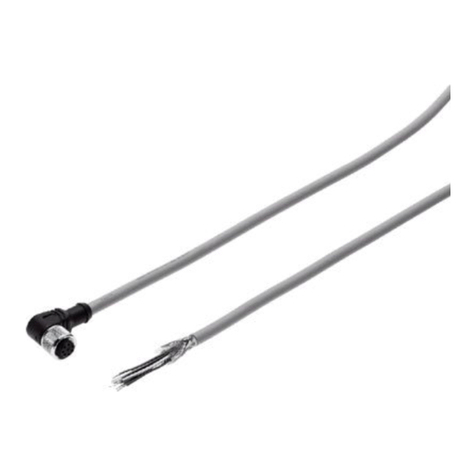
Festo
Festo NEBU-M12W8-K N-LE8 Series User manual


